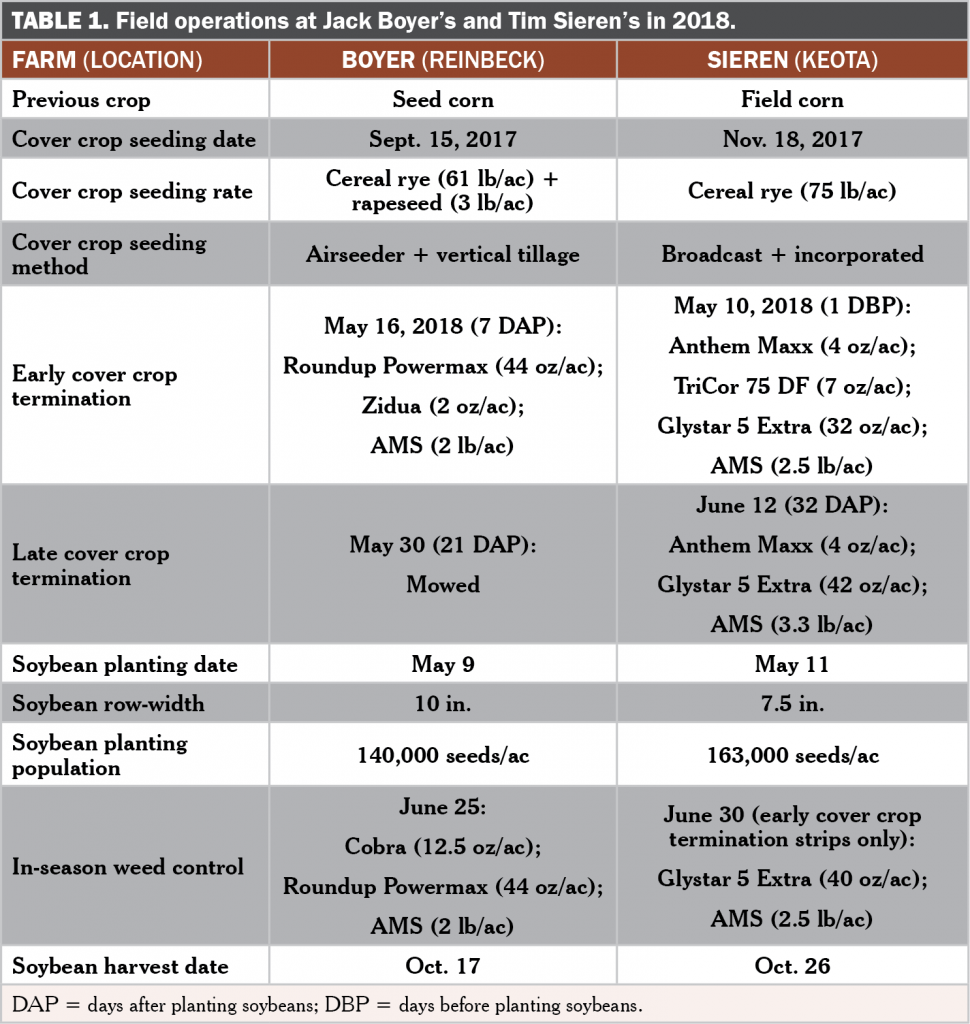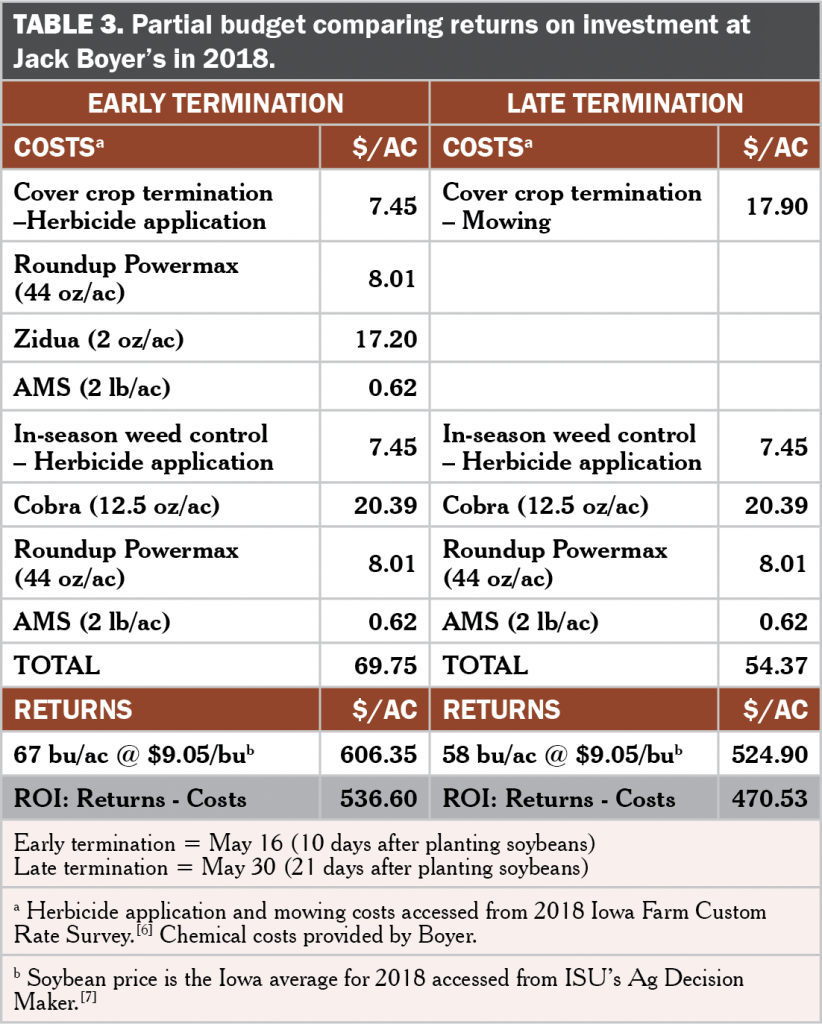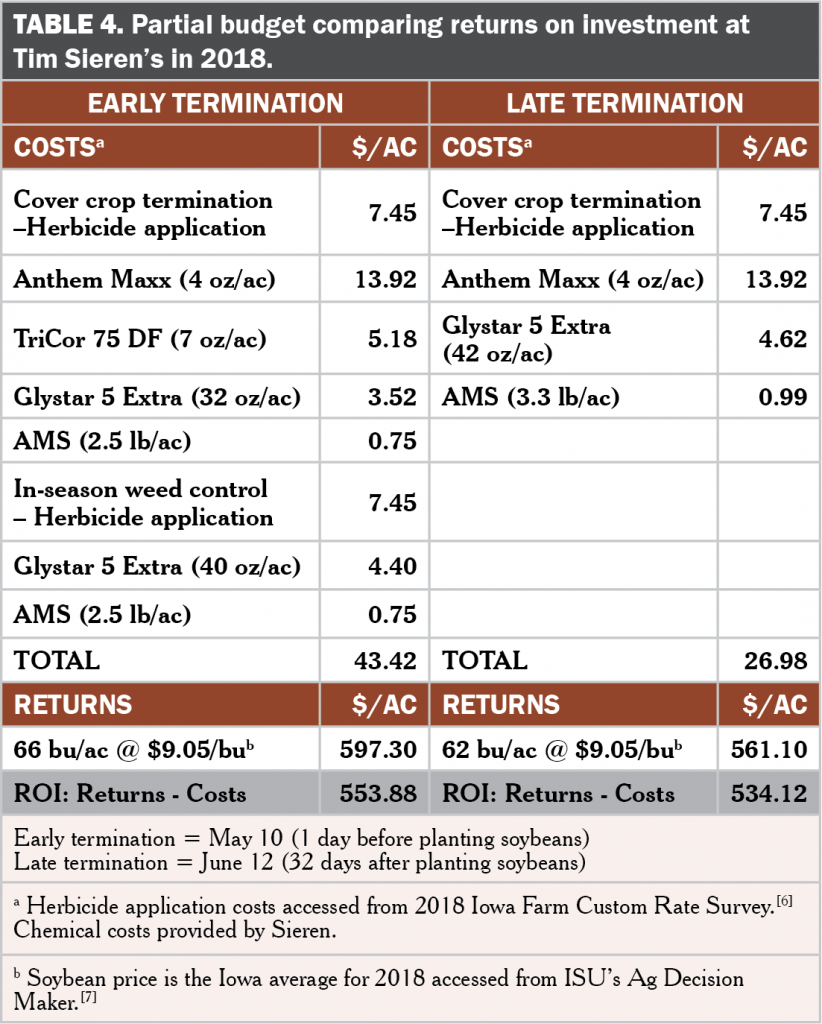In a Nutshell:
- Planting soybeans within one day of terminating a cereal rye cover crop does not reduce yield and can improve weed control compared to terminating the cover crop 10–14 days prior to planting soybeans.
- In experimental trials, farmer-cooperators Jack Boyer and Tim Sieren compared two cereal rye cover crop termination dates: early (near the time of planting soybeans) and late (three to four weeks after planting soybeans).
Key Findings
- Compared to the early cover crop termination treatment, the late termination reduced soybean yields by 9 bu/ac at Boyer’s and by 4 bu/ac at Sieren’s.
- The late cover crop termination treatment resulted in less costs at both farms. Boyer mowed the cover crop and chose to forgo a residual herbicide, reducing costs by $15.38/ac. Sieren only terminated the cover crop and eliminated in-season weed control, reducing costs by $16.44/ac.
- Because of lower yields, however, returns on investment were reduced at both farms in the late termination treatment: by $66.07/ac at Boyer’s and by $19.76/ac at Sieren’s.
Background
In previous studies, PFI cooperators Jack Boyer, Jeremy Gustafson and Bob Lynch tested the effects of “planting green”: planting soybeans within one day of terminating a cereal rye cover crop.[1,2] In four of the five trials involved in those studies, planting green resulted in statistically similar soybean yields compared to terminating the cover crop 9–24 days before planting soybeans. Both Boyer[1] and Gustafson[2] were able to reduce weed management costs in one trial each thanks to the increased amount of cover crop residue when planting green. More recent work by researchers at the University of Wisconsin has explored terminating cover crops two to four weeks after planting soybeans with a roller-crimper in organic production systems. In the first year of that study, this technique resulted in yields reduced by 8–17 bu/ac compared to when soybeans were planted later in the season on the same day as terminating the cover crop.[3] In the second year, waiting to terminate the cover crop until two to four weeks after planting soybeans resulted in equal yields among soybean planting and cover crop termination date treatments.[4] With this previous work in mind, PFI cooperators designed experiments to assess the feasibility of delaying cover crop termination until three to four weeks after planting soybeans in conventional production systems.
“I wanted to further explore weed control and the possibility to reduce herbicide costs with cover crops,” Jack Boyer said about his motivation for conducting the trial (and alluding to his previous trials). Achieving more biomass from a cereal rye cover crop ahead of soybeans was one of Tim Sieren’s goals. “Hopefully it would allow me to cut down on herbicide inputs,” he added.
Objective: Determine if terminating a cover crop three to four weeks after planting soybeans can maintain soybean yields and reduce herbicide use compared to terminating a cover crop near soybean planting.

At left, photo taken June 11, 2018. At right, photo taken on June 30, 2018. In both photos, strips at Tim Sieren’s where the cover crop was terminated 1 day before planting soybeans (left) and 32 days after planting soybeans (right).
Methods
Experiments were conducted by Jack Boyer near Reinbeck in Tama County and Tim Sieren near Keota in Washington County. Treatments involved two cover crop termination dates: early and late. Early termination occurred seven days after planting soybeans at Boyer’s and the day before planting soybeans at Sieren’s. Late termination occurred 21 days after planting soybeans at Boyer’s and 32 days after planting soybeans at Sieren’s. At both farms, treatments were arranged in a randomized complete block design and replicated four times in strips running the length of each field. Cover crop and crop management details for both farms are provided in Table 1.
Field sampling
Cover crop aboveground biomass samples were collected shortly before each termination date at both farms. Samples were weighed after air-drying for six weeks.
Soil samples were collected to a depth of 6-in. on June 13 at Sieren’s and June 15 at Boyer’s. Samples were sent to AgSource Laboratories (Ellsworth, IA) to determine the burst of CO2-C following rewetting of dried soil using the Solvita assay.
Soybeans were harvested individually from each strip in October at both farms and corrected to 13% moisture.
Data were analyzed using JMP Pro 13 (SAS Institute Inc., Cary, NC) statistical software. Means separations are reported using the least significant difference (LSD) generated by a t-test. Statistical significance was determined at the 95% confidence level.
Results and Discussion
Cover crop biomass
Boyer and Sieren collected samples of cover crop aboveground biomass at the time of both termination dates. Biomass samples were not collected from each of the replicated strips at both farms, however, which precluded statistical analysis. Both farms observed far more cover crop growth with the late termination date (Table 2). Though, a particularly cool and dry April probably reduced biomass potential at both farms (Figure A1).
Soil health
Boyer and Sieren collected soil samples from the strips in mid-June and sent them to AgSource Laboratories (Ellsworth, IA) to determine the burst of CO2-C following rewetting of dried soil using the Solvita assay. This assay measures the amount of CO2-C that is respired from the soil over a 24-hr period – the more CO2-C that is respired from the soil, the more biological activity in the soil (e.g., the healthier the soil). Cover crop termination date did not affect the amount of CO2-C respired from the soil at either farm (Figure 1).

FIGURE 1. CO2-C burst from the soil as determined by the Solvita assay in mid-June at A) Boyer’s and B) Sieren’s as affected by cover crop termination date. Columns represent individual strip values. Above each set of columns is the treatment mean. By farm, because the differences between the treatment means is less than the least significant difference (LSD), the treatments are considered statistically equal at the 95% confidence level.
Soybean yields
Delaying cover crop termination until three to four weeks after planting soybeans reduced yields at both farms. Compared to the early termination, the late cover crop termination reduced soybean yields by 9 bu/ac at Boyer’s and by 4 bu/ac at Sieren’s (Figure 2). At Boyer’s, soybean yields from the early termination treatment exceeded the five-year Tama County average of 59 bu/ac,[5] but yields from the late termination treatment fell just below the five-year average. Regardless of cover crop termination date at Sieren’s, soybean yields exceeded the five-year Washington County average of 59 bu/ac.[5]

FIGURE 2. Soybean yields at A) Boyer’s and B) Sieren’s as affected by cover crop termination date. Columns represent individual strip yields. Above each set of columns is the treatment mean. By farm, if the difference between the treatment means is greater than the least significant difference (LSD), the means are followed by different letters and the treatments are considered statistically different at the 95% confidence level.
Economic analysis
Tables 3 and 4 provide partial budget summaries of the returns on investment for the treatments at both farms. Costs associated with cover crop seeding, soybean planting, and soybean harvest were incurred between treatments and were thus not considered when calculating the returns on investment. Rather, only the costs that differed between the treatments at both farms were considered in the partial budget summary tables. Returns on investment were greater in the early termination treatment at both farms. Compared to the early termination treatment, the returns on investment in the late termination treatment were reduced by $66.07/ac at Boyer’s (Table 3) and by $19.76/ac at Sieren’s (Table 4). The reduced returns were due to lower soybean yields in the late termination treatment at both farms (Figure 2).
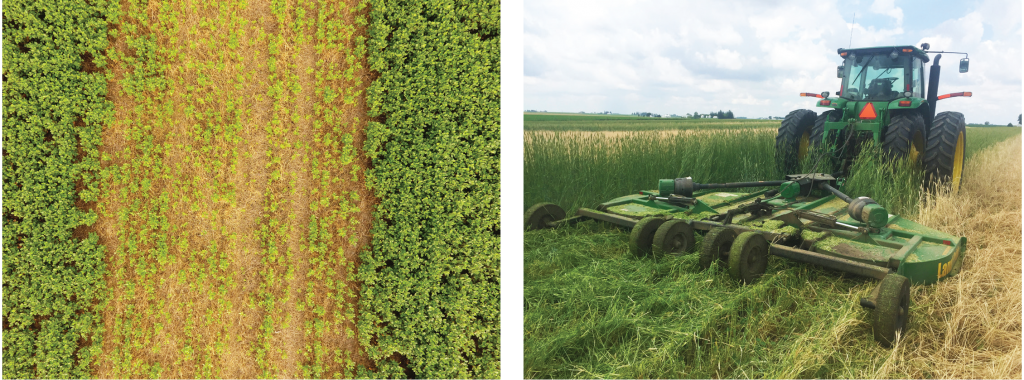
At left, strips at Jack Boyer’s where the cover crop was terminated 21 days after planting soybeans (center) and 7 days after planting soybeans (left and right). Photo taken July 11, 2018.
At right, Jack Boyer mowed the cover crop on May 30, 2018 in the late termination treatment (21 days after planting soybeans).
At both farms, the late cover crop termination treatment resulted in less costs. At Boyer’s, the late termination was achieved by mowing, which cost $15.38/ac less than the systemic (Roundup Powermax) and residual (Zidua) herbicides used in the early termination treatment (Table 3). Sieren chose to forgo both a pre-emergent herbicide (TriCor 75 DF) and in-season weed control in the late termination treatment which reduced costs by $16.44/ac (Table 4). “The weeds were suppressed by the cover crop residue,” Sieren said about the late termination treatment. The greater amount of cover crop residue in the late termination treatment (Table 1) served as a mulch and precluded a second herbicide pass.
Conclusions and Next Steps
In these experiments, Boyer and Sieren assessed the feasibility of terminating a cover crop three to four weeks after planting soybeans. Both had previous experience terminating a cereal rye cover crop within a few days of planting soybeans; such a strategy can result in chest-high cereal rye. In general, soil conservation and early-season weed suppression is improved with the more cover crop growth one can achieve. Waiting to terminate the cover crop until a few weeks after planting soybeans is a strategy for achieving more cover crop biomass for the purposes of improved weed control across the entire season. Boyer and Sieren were interested to learn if they could maintain soybean yields and reduce herbicide use with this strategy.
Boyer terminated the cover crop 21 days after planting soybeans; Sieren terminated 32 days after planting soybeans. Both farms saw much more cover crop growth with this strategy compared to when they terminated the cover crop earlier, near the time of planting soybeans (Table 2). The late cover crop termination, however, reduced soybean yields (Figure 2). Both Boyer and Sieren incurred less herbicide costs in the late termination treatment. These lower costs were not enough to overcome the lower yields – both saw reduced returns on investment in the late termination treatment (Tables 3 and 4). “I will not delay termination to 21 days after planting soybeans again due to the reduction in yield,” Boyer said about the results. “We tried to push the envelope for termination date a bit too far so I’m going to continue my practice of terminating the cover crop within five days of planting soybeans.” Though he saw lower yields and returns with the late termination date, Sieren was impressed by the cover crop’s potential to reduce herbicide use. “This trial proved to me that cover crop residue can suppress weeds in no-till soybeans,” Sieren said. “We are planning to repeat this trial in 2019,” he added. “In 2018, I was planning on the late termination occurring two to three weeks after planting soybeans, but it rained in early June and I wasn’t able to get in with the sprayer until mid-month (about a month after planting the soybeans). In the future, I hope to refine the timing of soybean planting and cover crop termination to try and minimize the yield difference between early and late termination of cover crops.”
Appendix – Weather Conditions
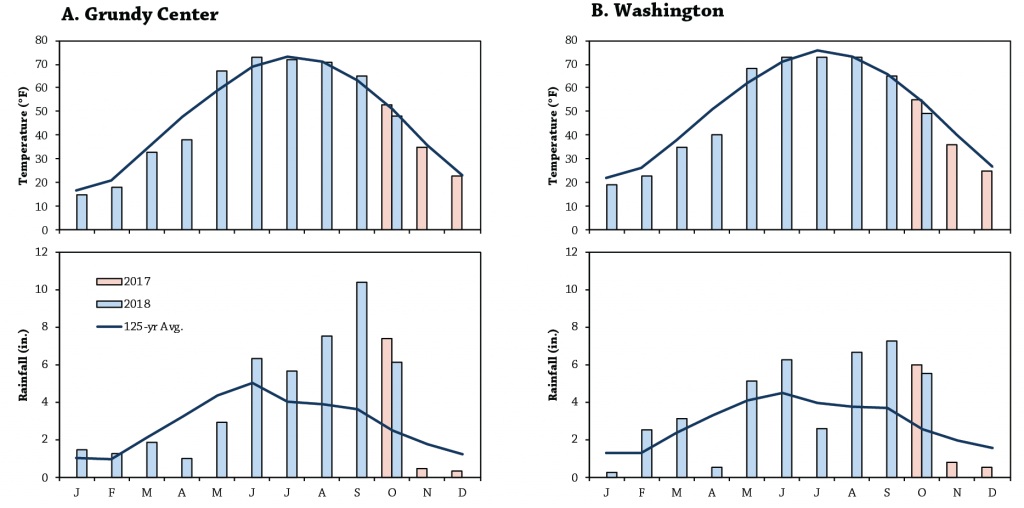
FIGURE A1. Mean monthly temperature and rainfall for Oct. 1, 2017 through Oct. 31, 2018 and the long-term averages at the nearest weather stations to each farm.[8] A) Grundy Center (Boyer, about 9 miles away) and B) Washington (Sieren, about 9 miles away).
References
- Gailans, S., B. Lynch, J. Gustafson and J. Boyer. 2015. Cereal Rye Cover Crop Termination Date Ahead of Soybeans. Practical Farmers of Iowa Cooperators’ Program. https://practicalfarmers.org/wp-content/uploads/2018/10/15.FC_.CC.Cereal_Rye_Cover_Crop_Termination_Date_Ahead_of_Soybeans-1.pdf (accessed March 2019).
- Gailans, S., J. Gustafson and J. Boyer. 2016. Cereal Rye Cover Crop Termination Date Ahead of Soybeans, 2016 Update. Practical Farmers of Iowa Cooperators’ Program. https://practicalfarmers.org/wp-content/uploads/2018/10/16.FC_.CC.Cereal_Rye_Cover_Crop_Termination_Ahead_of_Soybeans_Update_2016.pdf (accessed March 2019).
- Silva, E. and L. Vereecke. 2017. No-Till Soybean Trial. OGRAIN Factsheet 18-1. University of Wisconsin Organic and Sustainable Agriculture Research and Extension. https://ograin.cals.wisc.edu/wp-content/uploads/sites/65/2018/01/OGRAIN-Fact-Sheet-18-1-No-Till-soy-2017-REVISED-5.pdf (accessed April 2019).
- Silva, E. and L. Vereecke. 2018. No-Till Soybean Trial 2018. OGRAIN Factsheet 19-1. University of Wisconsin Organic and Sustainable Agriculture Research and Extension. https://ograin.cals.wisc.edu/wp-content/uploads/sites/65/2019/01/Notillsoy2018.pdf (accessed April 2019).
- US Department of Agriculture-National Agricultural Statistics Service. Quick stats. USDA-National Agricultural Statistics Service. https://quickstats.nass.usda.gov/ (accessed March 2019).
- Plastina, A. and A. Johanns. 2019 Iowa Farm Custom Rate Survey. Ag Decision Maker File A3-10. Iowa State University Extension and Outreach. https://www.extension.iastate.edu/agdm/crops/pdf/a3-10.pdf (accessed March 2019).
- Johanns, A. 2019. Iowa Cash Corn and Soybean Prices. Ag Decision Maker File A2-11. Iowa State University Extension and Outreach. https://www.extension.iastate.edu/agdm/crops/pdf/a2-11.pdf (accessed March 2019).
- Iowa Environmental Mesonet. 2019. Climodat Reports. Iowa State University. http://mesonet.agron.iastate.edu/climodat/ (accessed March 2019).


